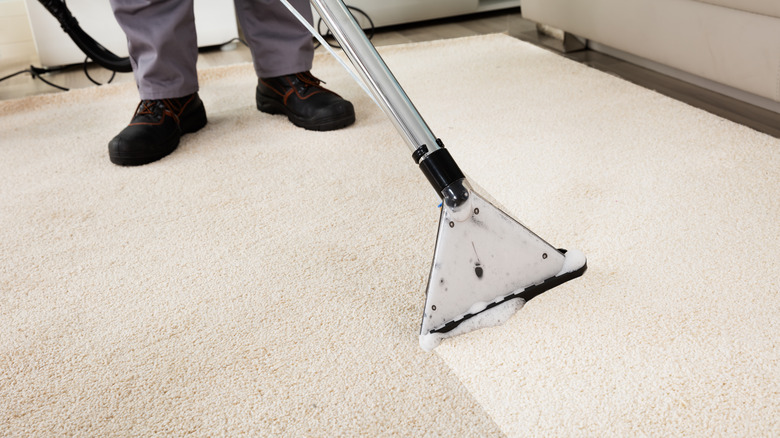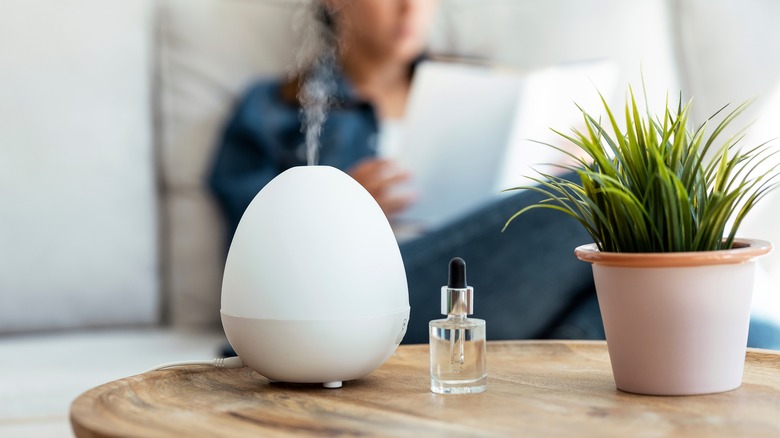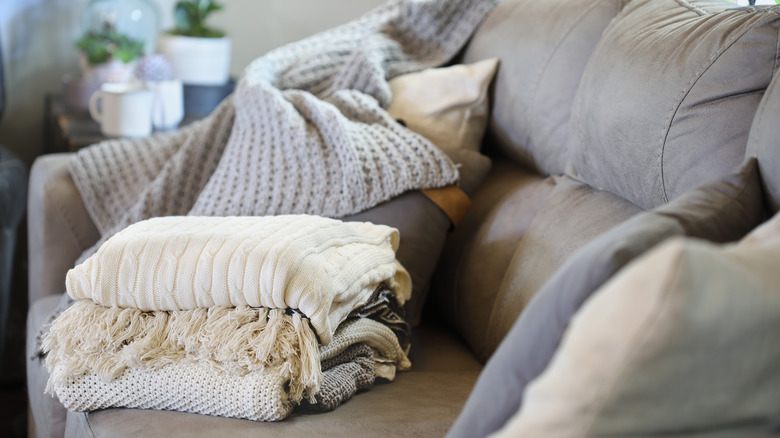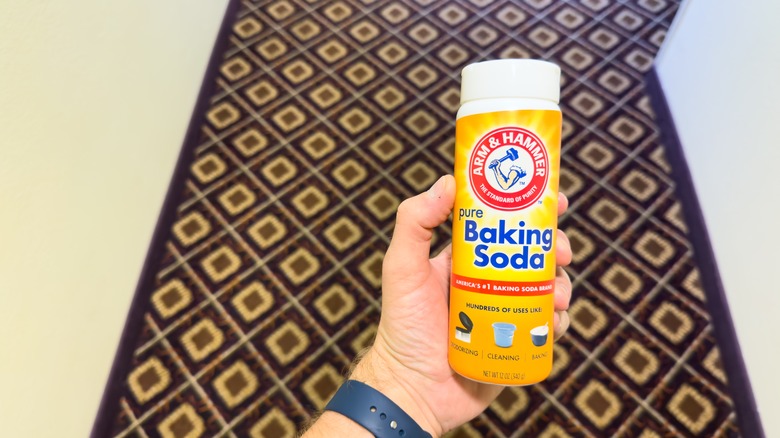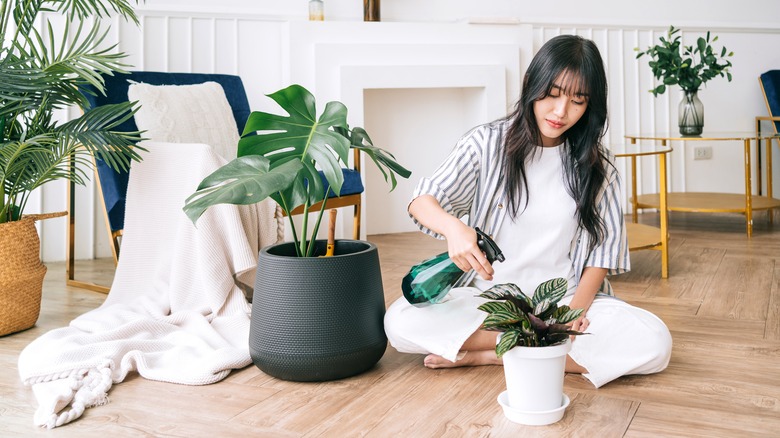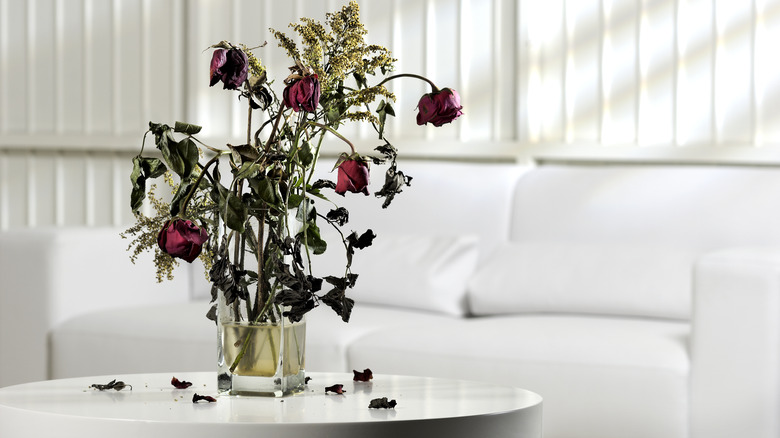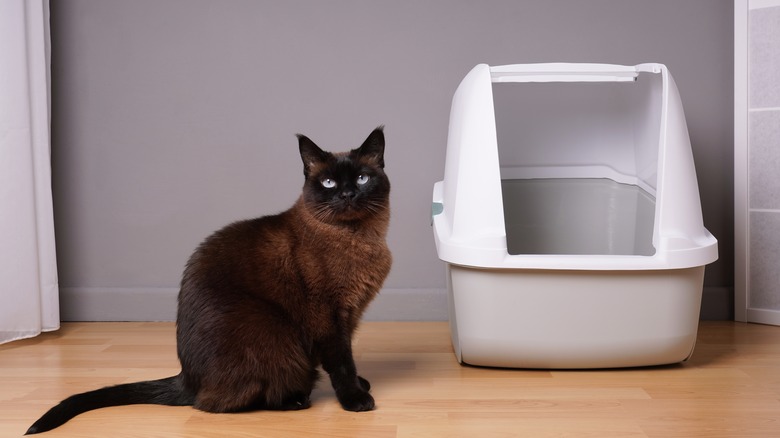10 Things People With Nice Smelling Living Rooms Never Do
We may receive a commission on purchases made from links.
A house is so much more welcoming when it smells nice, and this is particularly true for a gathering place like the living room. However, the question is how, exactly, do you get it to smell so inviting? There are certain things that people with nice-smelling living rooms never do, which keep things fresh and clean throughout the week. There is nothing worse than walking into a house only to be hit in the face with a symphony of odors. Whether it's from pets, lingering body odors, or an earthy mustiness, they all lower the atmosphere in the living room and make you not want to hang out for long.
To remedy the situation, take note of what people with fresh-smelling living rooms avoid doing. This can range from obvious things, like not keeping the windows closed to allow fresh air to circulate, to less apparent ones, such as not going overboard with air fresheners, as they lower the air quality. These tips ensure that you're avoiding anything that could contribute to a bad smell in the room, from allowing dust to linger on shelves, which can create a stale odor, to neglecting deep cleaning upholstery. Let's take a closer look at what people with nice-smelling living rooms never do.
Avoid deep cleaning their carpets
While it's easy enough to mop your floors, removing all the dirt and debris that has built up over the week, you can't mop your carpets. Though vacuums can pick up surface dust and grime, they don't get to the bottom of the pad, where debris can hide. Everything from crumbs to tracked-in dirt to skin flakes can embed themselves in the fibers, which will eventually cause a less-than-fresh odor. That's because the organic matter can break down, and bacteria can begin to accumulate and multiply, which gives off a musty smell. Because of this, people with nice-smelling living rooms make it a priority to routinely deep clean their area rugs and carpets.
It's recommended to deep clean these areas once a year in low-traffic rooms. However, if you have pets, children, or a large family with plenty of foot traffic, you want to increase that number to a minimum of once every six months. You can go about this in one of two ways. The first is to DIY the cleaning yourself using a wet carpet vacuum like the Bissell Crosswave Wet Dry Vacuum, which retails for $230. For carpets that need a deeper and more robust cleaning, you can rent a carpet cleaner from a hardware store like Home Depot. The second option is to take your area rugs to a professional rug cleaner, who will give them a thorough scrubbing.
Neglect deep cleaning their couch cushions
A lot of living happens on our couches. It's where you unwind with hours of TV and popcorn, eat your dinner after a long day of work (even though you know you shouldn't!), snuggle up with your pets, and even where you plop down after returning from a sweaty workout. All of these day-to-day activities create an accumulation of food, sweat, pet odors, and stains, so people with fresh-smelling living rooms make it a priority to routinely deep clean their upholstery. This removes all the body odor, food spills, and pet smells from the fabric, improving the air quality in the space.
Before you dive into washing your couch with a wet-dry vacuum, first take a peek at the manufacturer's tag to double-check if you can do so. Some fabrics can't tolerate wet cleaning, and using wet-dry vacuums or spot removers can stain them. If there is a "W" code, that indicates you're safe to use water on it. "S" means to use a solvent-based cleaner instead, whereas "WS" means you can do either/or. But, if you see an "X," you can't use any liquid and can only vacuum. For those, it's best to have the couch deep cleaned by a professional upholstery cleaner.
Add too many air fresheners in the space
This might sound counterintuitive. Air fresheners make the room smell better, so why would people with nice-smelling living rooms avoid them? There are two reasons. The first is that having too many air fresheners can create competing smells in the room, making it unpleasant to sit in the space.
However, most importantly, air fresheners have been proven to worsen the air quality in the room. Studies have shown that a single plug-in can contain hundreds of toxic chemicals. They emit harmful VOCs into the air, which can pose a danger to your health. When testing 25 scented products, researchers found that, on average, each product emitted 17 VOCs, a max of eight toxic chemicals, and created at least one cancer-causing air pollutant (via National Institute of Environmental Health Sciences). Instead, it's better to find an unscented way to make our rooms smell fresher.
You can do this by locating the source of the odor you're trying to mask. For example, if the room smells musty, then you might need to deep clean it to remove dust and body oils. If it appears mildewy, then dampness could be the issue, and a dehumidifier can help. If your room has poor ventilation, because you live in an old building or home, then setting up an air purifier can freshen the air in the space.
Keep the windows closed
There are all sorts of reasons why you would want to keep your windows closed. Maybe you live in an area with harsher weather, and you want to avoid letting in cold or humid air. Perhaps you live near a busy street or highway, where noise levels and pollution are higher than you're comfortable with. Whatever the reason, you might need to find a workaround if you want a pleasant-smelling living room. That's because open windows provide ventilation and help to remove musky or stale air, and let in fresh air.
According to the CDC, there are several ways to get more fresh air in and increase the airflow in the room. The first is to open any windows or doors in the space. But if you would rather keep your exposure to the outside at a minimum, then leaving a window open a few inches will be sufficient to circulate new air into the room. You can also move the stale air out by simply turning on the exhaust fans in the bathroom and kitchen, and using ceiling or floor fans. If you need to push out musty smells from the room, put a floor fan near the window, which will help propel the air outside.
Avoid washing their throw pillows and blankets
It can be hard to convince yourself to clean your throw pillows and blankets. You might worry that throwing them into the washing machine will ruin the material, and hand washing it could be too cumbersome. But people with fresh-smelling living rooms routinely wash these items, mainly because they absorb and hang onto body smells. If you use your throw pillows as a place to rest your head from time to time, then oils from your hair and skin get onto the fabric. The same happens with blankets, with the bonus of sweat, pet smells, or food crumbs. Because of this, they can eventually emit musky odors.
If you use them regularly, then aim to wash them once a month. Take a look at the manufacturer's label to check how they should be washed. If they're silk or wool, they likely will need to be dry cleaned. If they can be machine washed, then use a gentle cycle with gentle detergent. For hand washing, fill a bucket with warm water and add a drop or two of gentle detergent. Allow them to sit for around 10 minutes, agitating the water now and then to help loosen any dirt or grime. Then rinse the item in warm water and let it air dry. To avoid making the material stiff, remove the covers and blankets from the line when they're about 75% dry and throw them into a "no heat" cycle in the dryer to finish their drying.
Allow dust to accumulate
Dust not only makes a room appear dingy, but it also plays a significant role in how your home smells. While its odor won't hit you in the face like a pair of stinky shoes, it emits a subtle, earthy smell. It's one of the unexpected reasons why a house smells musty, and it can even develop a faint mildew scent if it accumulates. "Musty smells are often caused in the home by a build-up of dirt and grime, which can cause a lingering, unpleasant smell," Amanda Lewis, marketing director at Elbow Grease, explained to Homes & Gardens. "To combat these smells, you must tackle the problem and clean the area deeply."
To keep this scent at bay, you want to aim to dust weekly, but every other week should suffice if that's too difficult a schedule. However, this all depends on who lives in your home. If you have pets, live with many people, and reside in an area that can bring in grime through the windows, then you want to increase the frequency to keep the space smelling fresh and clean. To properly dust, use a soft microfiber cloth that will help pick up and trap particles. Clean from top to bottom, ensuring any floating dirt falls to the floor, which you'll clean last.
Avoid deodorizing their rugs
Even if you vacuum your rugs weekly, sometimes they can still give off odors. That's because certain things linger in the fibers that vacuums can't pick up, such as sweat from bare feet, trapped humidity, and lingering smells from pet accidents. Because of this, people with nice-smelling living rooms don't put off deodorizing their rugs. You also don't need to buy a fancy cleaning product to do this. Instead, all you need is baking soda.
Baking soda is a natural deodorizer because it doesn't just hide odors, but eliminates them via chemical reactions. "Many unwanted smells are the result of acidic compounds," Audrey Pariés of cleaning brand Aspen Clean tells Martha Stewart. "Baking soda (sodium bicarbonate) is an alkaline substance, and when it comes into contact with acidic odors, it reacts to neutralize them. This chemical reaction between the baking soda and the acid neutralizes or produces a less odorous compound. The change in pH helps eliminate the smell."
To strip funky odors from your rugs and carpets, grab a sifter and use it to sprinkle baking soda across the entire length of your rug. Allow it to sit a minimum of 15 minutes for it to work its magic, but the longer you leave it, the more effective it will be. Then, simply vacuum up the powder and you should be left with fresher-smelling rugs.
Overwatering their plants
Overwatering your plants not only puts a strain on them but can also contribute to musty smells in the room. That's why people with pristine living rooms avoid this common houseplant maintenance mistake. Overwatering can lead to root rot, which is what happens when fungus takes over waterlogged soil and attacks the roots. It turns the roots mushy and brown, slowly killing the plant. Since the roots are essentially rotting and bacteria are growing in the pot, this releases a pond-like odor into the room. While it may not take over the entire room, you will be able to at least smell it if you pass by the planter.
To avoid releasing this unpleasant scent, take extra precautions so as not to overwater your plants. The usual rule of thumb is to only water when the first 2 inches of soil is dry, which usually translates to once a week. However, that's not always an accurate test since the top soil can be dry, but the bottom of the pot can be waterlogged. To get a better understanding of how wet your soil is, invest in a moisture meter, which runs for $13 on Amazon. You insert the prong into the dirt, and the meter will tell you how damp or dry it is, taking the guesswork out of watering schedules. You can also get a water dispenser (such as this $10 one from Amazon), which is a vessel filled with water that you put in the dirt. The plant will then drink the water when it needs it.
Leave out old vases of flowers
Another thing that can make your living room unexpectedly musty is an old vase of flowers. It's recommended to change the water in a vase every two days to keep bacteria buildup at bay. If you let the flowers sit in the same stagnant water for too long, bacteria breed in the moist conditions and can attack the stems. They then turn wet and mushy and begin to rot. Eventually, mold will start to form, all of which releases that pond-like smell into the air.
The best thing you can do to avoid this is to change the water every two days. To do so, take out a second, empty vase into which you can put the bouquet. Pour out the cloudy water and quickly rinse the vase to remove any buildup of bacteria. Fill the vase back up with water, but before you put the bouquet back in, grab a pair of pruning shears. Cut back each stem by about a 1/2 inch to remove the parts of the flower that might have started to decompose due to bacterial buildup. This will ensure that bacteria are not put back into the fresh vase.
House the litter box in the living room
If you own a cat and have a small apartment with limited space, you might be tempted to put the litter box in the living room. You may think this is your only choice, but if you want a fresh-smelling living room, then it's best that you reconsider. Thankfully, you have options.
Instead, there are several other areas you can stash your pet's bathroom. The first is in, well, your bathroom. Put it next to your toilet and make sure to leave the door wide open so your cat has easy access. If you don't have much room in there, opt for a simple and small box, such as this one on Amazon, which can easily fit between the wall and your commode. The second option is to put it in a bonus room you don't use as often, such as a sun room, an enclosed back porch, or a guest bedroom. However, make sure to clean the box daily, so unpleasant smells don't linger in the room. You can also stash it in the dining room if you don't use it frequently — just hide it in a piece of furniture, so it's not obvious that's your cat's bathroom. An example of this is transforming an IKEA bench into a hidden litter box. As long as it won't stress out your cat, just move it to a different room when guests come over.

